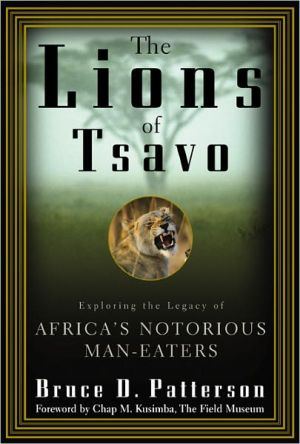A Little Over A Century Ago, At The Height Of European Colonial Expansion In Africa, The British Undertook To Tame The Wilderness With A Trans-kenya Railroad From Mombasa On The Indian Ocean To Lake Victoria. One Hundred And Thirty Miles In, At What Is Now The Tsavo National Park, One Of The World’s Largest Wildlife Preserves, Nature Struck Back In The Form Of Two Male Lions Which Began To Systematically Hunt, Kill, And Devour Railroad Workers. The Rampage Lasted For More Than Nine Months And Is Thought To Have Claimed The Lives Of 135 People. More Lives Would Have Been Lost If Not For Colonel John H. Patterson, A Civil Engineer Tasked With Building A Bridge Across The Tsavo River Who, After An Arduous 9-month Hunt, Killed The Lions, Earning The Title Of Liberator Among His Crews And International Acclaim As A Sportsman. The Story Of The Tsavo Man-eaters Had Captivated The Public’s Imagination For More Than A Century While Giving Rise To Considerable Scientific Debate.^ What Compelled Those Lions To Prey On Human Beings – Was It A Matter Of Necessity, Self-defense, Or Simply One Of Opportunity? And Why Are The Lions Indigenous To This Region Maneless? Is There Something About Maneless Lions That Makes Them Especially Prone To Becoming Man-eaters, Or Is Human Predation By Lions More Common Than We Have Been Led To Believe? What Can The Events Of 1898 Teach Us About The Extraordinary Tsavo Lions And About Lions In General? In An Effort To Answer These Questions, Bruce Patterson, Principal Investigator Of The Tsavo Research Program And Curator At The Field Museum, Where The Tsavo Man-eaters Are On Exhibit, Has Conducted Extensive Field Research Throughout The Region. Now, In The Lions Of Tsavo, He Shares His Findings. Working From Original Accounts, He Retells The Harrowing Story Of Those Bloody Nights In Kenya.^ In A Balanced Discussion Of Competing Alternatives, He Presents Forensic Evidence That The Man-eating Behavior Exhibited In 1898 Was Likely Due To Pathology, But Argues That Most Man-eaters And Stock-raiders Today Result From Human Encroachment On Wild Habitats. In Attempting To Solve The Century-old Mystery Of The Tsavo Rampages, Patterson Goes Beyond The Reign Of Terror Of 1898 To Offer A Natural History Of Panthera Leo. A Leading Expert On Lions And Their Ecology, He Shares Much About The Evolutionary Biology, Anatomy And Physiology, Social Behavior, Mating Patterns, And Hunting Strategies Of The King Of Predators. And In The Process, He Comes To The Somewhat Disconcerting Conclusion That, For Lions, Once They Have Tasted Human Flesh, Man-eating Very Quickly Becomes A Habit, A Routine, A Way-of-life.–jacket. Introduction : A Confluence At Tsavo — The Reign Of Terror : The Lions Of Tsavo Attack — The Terror Continues : Man-eating Lions Today — Killing Behavior And Man-eating Habits — Why Do Lions Kill People? — Lion Biology : Evolution And Geographic Distribution — Hunting And Social Behavior — The Lion’s Mane : Geographic And Individual Variation — Why The Lions Of Tsavo Are Maneless — Conservation And Tsavo National Parks. Bruce D. Patterson. Includes Bibliographical References (p. Xvii, 207-224) And Index.
Conversations & Contemplations from the New American West







